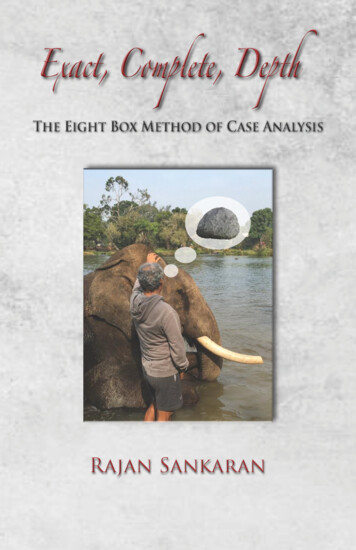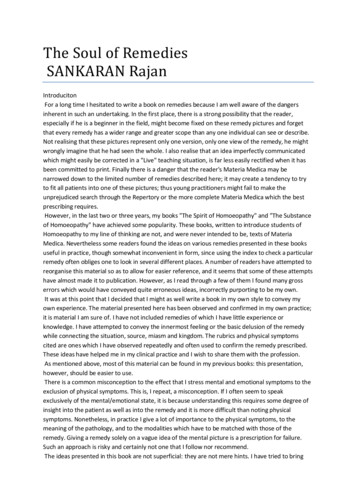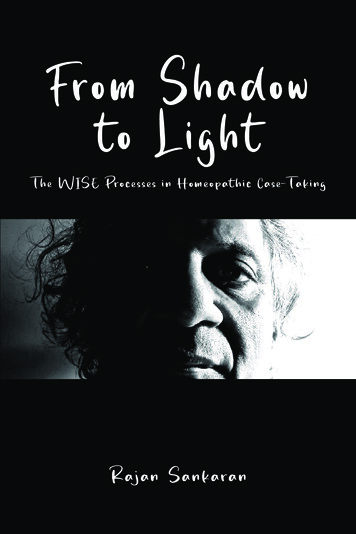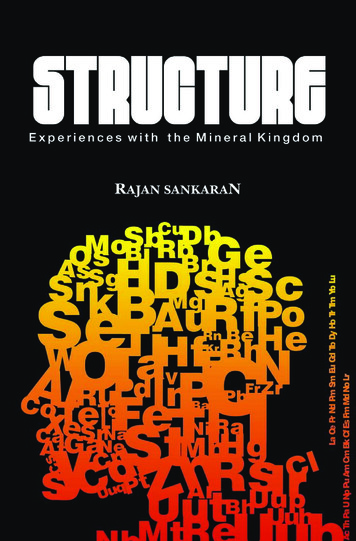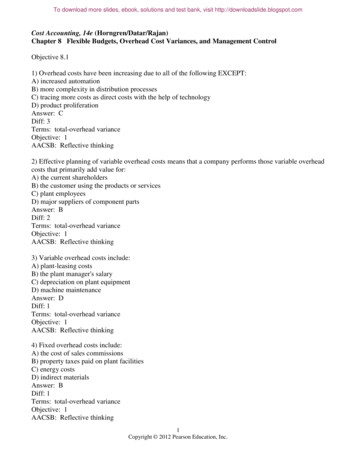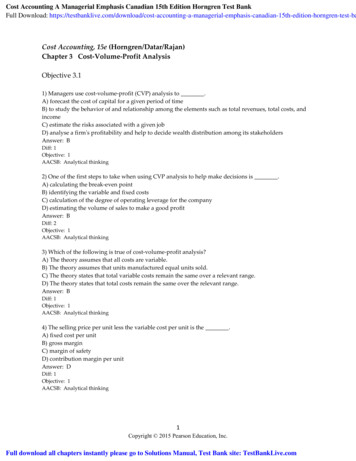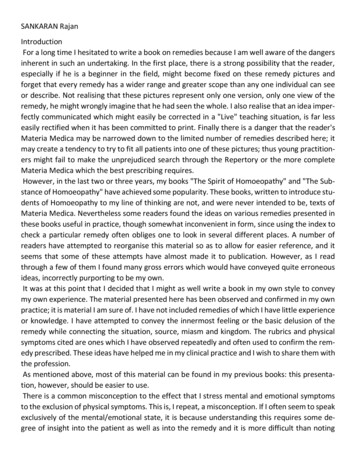
Transcription
SANKARAN RajanIntroductionFor a long time I hesitated to write a book on remedies because I am well aware of the dangersinherent in such an undertaking. In the first place, there is a strong possibility that the reader,especially if he is a beginner in the field, might become fixed on these remedy pictures andforget that every remedy has a wider range and greater scope than any one individual can seeor describe. Not realising that these pictures represent only one version, only one view of theremedy, he might wrongly imagine that he had seen the whole. I also realise that an idea imperfectly communicated which might easily be corrected in a "Live" teaching situation, is far lesseasily rectified when it has been committed to print. Finally there is a danger that the reader'sMateria Medica may be narrowed down to the limited number of remedies described here; itmay create a tendency to try to fit all patients into one of these pictures; thus young practitioners might fail to make the unprejudiced search through the Repertory or the more completeMateria Medica which the best prescribing requires.However, in the last two or three years, my books "The Spirit of Homoeopathy" and "The Substance of Homoeopathy" have achieved some popularity. These books, written to introduce students of Homoeopathy to my line of thinking are not, and were never intended to be, texts ofMateria Medica. Nevertheless some readers found the ideas on various remedies presented inthese books useful in practice, though somewhat inconvenient in form, since using the index tocheck a particular remedy often obliges one to look in several different places. A number ofreaders have attempted to reorganise this material so as to allow for easier reference, and itseems that some of these attempts have almost made it to publication. However, as I readthrough a few of them I found many gross errors which would have conveyed quite erroneousideas, incorrectly purporting to be my own.It was at this point that I decided that I might as well write a book in my own style to conveymy own experience. The material presented here has been observed and confirmed in my ownpractice; it is material I am sure of. I have not included remedies of which I have little experienceor knowledge. I have attempted to convey the innermost feeling or the basic delusion of theremedy while connecting the situation, source, miasm and kingdom. The rubrics and physicalsymptoms cited are ones which I have observed repeatedly and often used to confirm the remedy prescribed. These ideas have helped me in my clinical practice and I wish to share them withthe profession.As mentioned above, most of this material can be found in my previous books: this presentation, however, should be easier to use.There is a common misconception to the effect that I stress mental and emotional symptomsto the exclusion of physical symptoms. This is, I repeat, a misconception. If I often seem to speakexclusively of the mental/emotional state, it is because understanding this requires some degree of insight into the patient as well as into the remedy and it is more difficult than noting
physical symptoms. Nonetheless, in practice I give a lot of importance to the physical symptoms,to the meaning of the pathology, and to the modalities which have to be matched with those ofthe remedy. Giving a remedy solely on a vague idea of the mental picture is a prescription forfailure. Such an approach is risky and certainly not one that I follow nor recommend.The ideas presented in this book are not superficial: they are not mere hints. I have tried tobring out the innermost feelings of the remedy and it is not easy to discover these in patientsother than by artistic case-taking which delves deeply into such things as the patients delusions,dreams, hobbies, etc. What appears on the surface may be quite different from what is actuallyinside. For example, I had a case in which the expression was one of stage fright, but I observedthat, in that situation, the patient's reaction, tremendous panic and fear, was as if he was aboutto be killed.My idea of understanding a remedy is to grasp the connection that ties together its myriadsymptoms: the basic delusion, its source (kingdom), the miasm to which it belongs, its symptoms- all must be understood as aspects of a single whole if we are to even begin to truly understanda remedy. It is my attempt to trace out these connections that distinguishes this work from otherMateria Medicas. I believe, for example, that the "connecting link" in Sepia is the feeling thatshe is forced to do something against her intention. In the section on Sepia I try to show howthis "link" connects every aspect of the remedy. This has been confirmed by me in practice timeand again - I do not believe it is mere theory. and yet the reader must remember that this isRajan's experience and not necessarily the final word.Similarly, the understanding of miasms presented here, for example, the theme of sycosis asbeing "fixed" is not traditional. It is merely my own understanding and someone else's viewmight well be different. A complete discussion of my understanding of miasms is presented in"The Substance of Homoeopathy" and is not reported here. In many cases I have described the"situation" of the remedy under discussion. Let me note here that the situation of the remedyis not necessarily the actual situation of the patient; it is rather the situation in which he (unconsciously) perceives himself to be. Thus, when I say the Magnesium is an orphan, it meansthat the patient feels like an orphan though he may, indeed, still have living parents. People setup situations according to their perception of reality. Magnesium muriaticum, for example, feelsthat his friends will betray him and so avoids people. This only reinforces his feeling of beingfriendless.I wish to reiterate once again that a good Homoeopathic practitioner does not try to fit thepatient to a particular remedy, but seeks first to clearly understand the patient and then to findthe appropriate remedy through repertorization, the study of likely remedies in various MateriaMedicas and review of the experiences of other homoeopaths with those remedies. Rather thantrying to see what part of a considered remedy does fit the case, he must see what does not fitand must remain skeptical. The prescriber who would grow in skill must be able to recognisewhat does not fit and resist the tendency to "force" a fit. In this way he will be led to consideranother remedy which might look similar but is not. This is what I try to do and if you do the
same you may be able to develop pictures of lesser known remedies.This book is meant for those who have read "The Spirit of Homoeopathy" and "The Substanceof Homoeopathy" because it is those earlier works that most fully express my understanding ofthe Organon and Materia Medica. Without an understanding of my ideas on such things as casetaking, classification of remedies according to kingdom, miasms, etc., this book will not be ofmuch benefit. This work may be used as an adjunct to the previous works but not as a substitutefor them. The reader who attempts to use this book without understanding the fundamentalconcepts may easily find himself lost without a compass.Finally let me repeat that the reader must bear in mind that this book is based on the experienceof one homoeopath amongst the multitude and should be taken as "notes along the way", notas the final word. Used in this way it may be of value.acknowledgementI wish to acknowledge with gratitude the work done by Dr. Digish Doshi andDr. Rashmi Jaising. They are mainly responsible for painstakingly collecting the material fromthe earlier two books and putting it into its present form, after discussion with me regarding myideas on the remedy.I am grateful to Mr. Michael Zelnick who has gone through the text and put in finishing touchesand Mr. T.D. Anthony has been patient with us during the typing.NoteRubricsUsually from Synthetic Repertory.Occasionally from Complete Repertory.Where marked from Kent's RepertoryPhatakRefers to Phatak's Concise Repertory.There are also symptoms from Phatak's Materia Medica.The rubrics and symptoms mentioned at the end of the remedy are those I see as the mainrubrics of the remedy and which I use for confirming the remedy.RemediesAconitum napellusAconitum napellus is a plant. The remedy prepared from it belongs to the acute miasm and is,in fact, the most acute of all our remedies.The main feeling of Aconitum is of a sudden, intense threat from outside that comes suddenlyand goes suddenly. For that moment the person, who is otherwise calm becomes intensely restless, panicky and nervous. This feeling of a sudden threat is seen in the fear of walking across abusy street, fear of accidents, of suffocation, in presentiment of death and in the delusion that
he is about to die. Mentally this is expressed as a fear of death, anxiety and restlessness etc.,while in the physical sphere, we find a racing pulse, palpitation and flushing of face alternatingwith paleness, etc.Aconitum is excitable. The patient can flare up suddenly, can get frightened very easily. Paincan drive him beside himself and again this excitement will be manifested suddenly and violently, with great restlessness - an acute panic reaction.Great nervous excitability is the most important component of Aconitum. We must look for anexcitable person and not a calm one, if we are to prescribe Aconitum - one who cannot takeanything easy; everything excites him. Here it comes close to Nux vomica, Chamomilla, Staphisagria, Coffea and Graphites. But Aconitum is also very very restless. There is anxious restlessness.Pierre Schmidt feels it is the most important remedy for anxious restlessness. Nux vomica,Staphisagria, Coffea or Ignatia are not so restless. Aconitum just can't sit still. He tosses about.This is similar to Arsenicum and Rhus toxicodendron, it is only much more intense, vigorous,sudden and acute. It is a sudden burst of excitement, fear or anxiety with great restlessness. Hedoesn't know where to go or what to do, his mind is ruled over by tremendous anxiety and fear.Then this whole state disappears as suddenly as it had come without leaving a trace.Aconitum avoids crowds, crossing the street, indeed any other situation that would cause excitement of mind. The proving reads: "Fear to go where there is any excitement". Sudden, intense fear from trivial causes is characteristic. It is not the insecure feeling of Calcarea or theterror of Stramonium nor the anxiety about health of Arsenicum, Nitric acid or Kali arsenicosum.It is an intense, sudden, panic state - something severe - the end, death! The rubric "Predictsthe time of death" is a combination of "Clairvoyance" with "Intense fear of death". But as I saidearlier, this is not the permanent state of Aconitum. Soon the excited state passes off and thenormal state re-emerges.But even in his normal state, Aconitum is hurried. As the proving reads: "He does everything ina hurry, runs about the house". His speech is hasty, jerky and excited: "Great impatience","Wants things at once", "On attempting to think of one thing, another thought intrudes, this issoon supplanted by another one and so on".Excitability can also make him cheerful, laughing, singing, dancing. But here too, the slightesttrifle can change his cheerfulness to anxiety: "Alternate attacks of opposite states of humour";"Fitful moods". It is this cheerfulness of Aconitum that differentiates it from Argentum nitricumand Arsenicum. These phases of excitable cheerfulness are not seen in the later remedies.He can at times become very irritable, violent, intolerant of contradiction, shrieking, censoriousbut will cool down soon. It is this sudden excitability that brings on such a state. There can alsobe episodes of intense sadness which pass off soon, accompanied by the anguish, restless,moaning and groaning of Aconitum.There are also sleep symptoms: somnambulism and talking in sleep. Dreams are anxious andclairvoyant. Sleep is anxious, restless, with constant tossing and turning, and starting in sleep.Aconitum is complementary to Sulphur.
Physical concomitants are- Face expression, anxious, frightened.- Thirsty, burning.- Heat, palms.- Discolouration red cheeks.- Perspiration, uncovered parts, on.- Desires: beer, bitter drinks, acids.- Sleeps on back with hands under the head or sleeps in a sitting posture with head inclinedforward, can't lie on sides.- Palpitation with great anxiety.- Face, red-hot.- Respiration oppressed.- Limbs feel weak.- Moaning, groaning, howling, loud whining or weeping;- Easily startled by noise.- Heat and discolouration, red, of face, in anxiety and excitement.Rubrics- Beside oneself, being.- Beside oneself, anxiety from.- Death, dying, feels as if.- Excitement, nervous.- Loquacity.- Mood, changeable.- Speech, hasty.PhatakBesides himself, frantic, madness from pain.- -AluminaAlumina is the oxide of the metal Aluminium. In the Periodic Table, Aluminium belongs to groupIII-A and is associated with Boron (from which the remedy Borax is made). Alumina is one of thegreatest anti-syphilitic remedies along with Syphilinum, Aurum and Mercurius. In Syphilinum,there is a total absence of hope which is one of the most essential things to the life of a humanbeing. Phatak mentions: "Hopeless despair of recovery" - total hopelessness. ThereforeSyphilinum is a remedy of death and destruction, he can be suicidal or homicidal. In Mercurius,the person's independence, another thing essential for life, has been taken away, and so hebecomes revolutionary, defiant, homicidal or suicidal. Then you have a need for acceptance insociety, some religious feelings; you take this away from man and you have Aurum - suicide
again. In Alumina, the person's identity or individuality has been taken away, and there is confusion.The Alumina person's identity has been so much suppressed that he doesn't know who he isanymore. He is so confused because someone has tried to shape him into something that he isnot. It is one of the most important remedies for confusion of identity in our Materia Medica.The situation of Alumina may arise as for example from a conflict between parent and child,where the child is not being given an identity. Whatever the child does, they say: "No, not this!"His individuality and identity have been broken down. Whatever the child says is not right - "Youare no one, you know nothing!" Then comes despair: "I don't know what to do. I don't knowwhat I am, who I am. I don't even know what I want, what I want to be. I am so small, so timidand completely dependent on the parent."Alumina is listed under the rubrics: "Irresolution, timidity and fear", "Delusion, head belongs toanother". The patient doesn't even know to whom his head belongs. He feels as if somebodyelse thinks for him, and he can't think for himself. He feels as if someone else heard or saidsomething when it was he who heard or said it. His real identity is being suppressed, is beingpushed in, so that he has to mould himself according to what other people want. Sometimesthe parental control is so strong that the child loses his identity and becomes impulsive, forexample he may grab someone's hand, or has impulsive acts of violence. In failed cases of Alumina, there is a tremendous sense of desperation to the extent of suicidal tendencies: "Morbidimpulses to shoot himself", "Impulse to cut herself even though she abhors the idea". This showsthe impulsiveness, the destructiveness, irresolution, timidity and fear.Control is a big theme in Alumina. A lot of his problems have to do with control - control of thebody, of the limbs, impulses, a fear of losing control. As the mental will has been undermined(symptom: "Weak will"), so also the will is taken away from the muscles too, and he can't moveproperly, he has no balance. At the same time, Alumina likes to be in control of situations. Beinga mineral, there is also an element of organization, of fastidiousness. A man who has lost hisidentity has to be fastidious, has to do everything perfectly according to someone else, otherwise he feels completely humiliated and finished.He feels he needs to be hard and rigid in order to keep up his identity, thus in the coped-upstate the Alumina-patient can be quite hard and rigid.Hence the rubrics:- Timidity alternating with assurance.- Obstinate, resists the wishes of others.- Defiant.One case of Alumina that I remember well is that of a patient who spoke of himself as if speakingof an object, or as if he were reading a weather report. He sounded detached hardly ever usingthe personal pronouns "I" and "My". For example he said: "The itching sensation was almostwild. It became a permanent feature on the face. There was a lot of sticky fluid on scratching.It appeared and the face became bright red. It is worse from sunlight." He also argued a lot,
almost endlessly, as if to establish his own identity by arguing. When someone needs to argueendlessly, it is only to create and maintain the identity he does not feel he possesses.Alumina might be a good remedy for left-handed children who have been forced to write withtheir right hand. They are forced to lose their identity and become confused as to whether theyare left-handed or right-handed. When you force a child to be something other than what henaturally is, you encourage the Alumina situation.Rubrics- Confusion, identity, as to his.- Delusion, head belongs to another.- Delusion, identity, errors of personal.- Contradictory to speech, intentions are.- Impulse, morbid.- Suicidal disposition, seeing blood or a knife, she has horrid thoughts of killing herself, thoughshe abhors the idea.- Fastidious.- Ailments, scorn, being scorned.- Contemptuous.- Obstinate, resists wishes of others.Kent- Choking, oesophagus, swallowing.Phatak- Fear, impulse, of his own.- Soles soft, furry.- Talks, through him, other person, as if.Ambra griseaAmbra grisea is an animal remedy. It belongs to the sycotic miasm.Like other animal remedies it has the quality of divided will. It has two wills and has a kind ofcontempt for self. It also has traits such as animation, loquacity, sexuality, playfulness, love ofanimals, etc.It is a sycotic remedy; an Ambra grisea woman feels that something is wrong with her thatneeds to be covered up. There is an intensely dirty feeling about herself. The expression "I feellike shit" aptly describes the main feeling of Ambra. The feeling is that something in her is intensely disgusting and that this part should never be exposed or she will be completely forsaken.Ambra feels a tremendous sense of embarrassment. Other remedies like Silicea, Carbo vegetabilis, Plumbum, Gelsemium, etc., also have something of this feeling, but Ambra feels it intenselyand is acutely conscious of the slightest thing she does. This embarrassment is more when itcomes to personal habits like passing stool and urine.
The symptom of Ambra: "Cannot pass stool in presence of others" describes this feeling exactlyas if to say that "this disgusting part in me should never be revealed to others or they will consider me disgusting". This symptom means that the patient cannot even have somebody in thenext room when he is passing stool. It means that the sounds that he makes in the toilet embarrass him so much that he cannot bear the thought of somebody standing even in the next room.He would like to clear the whole house before he passes stool, to see that there is nobodyaround. This is the nature and degree of embarrassment in Ambra. Indeed, he cannot even bearthe thought of going to somebody else's house, afraid he may get an urge for stool. When hegets the urge for stool, he gets anxious: "Anxiety with ineffectual urging for stool". This is a formof anticipatory anxiety in Ambra grisea.This feeling of embarrassment creates tremendous shyness in company and in the presence ofstrangers. Because of its symptoms "Bashful" and "Strangers, in presence of " it comes quiteclose to Baryta carbonica. But Ambra has this very acute feeling of embarrassment which Barytacarbonica doesn't have; Baryta carbonica has a tremendous irresolution which represents thefeeling of lack of capability, which is not seen in Ambra.Young girls with this Ambra feeling, in their embarrassment can talk in a flitting, flighty manner.They can also become mischievous and play pranks that are very much in keeping with thistheme of shame and shamelessness. Embarrassment about one's own body is one of the mainthemes. Also there is a feeling of embarrassment after doing something she considers disgustingor shameful.Among other symptoms of Ambra I have noted: "Fear of night" and fear "As if diabolical facescrowd upon her to swallow her". I have also noted in Ambra a love for whales.Rubrics- Anxiety, company, when in.- Anxiety stool before, ineffectual desire for, from.- Company, aversion to, presence of other people agg. symptoms, desire for solitude.- Company, aversion to, presence of people intolerable to her during stool.- Delusion, faces sees, diabolical around, upon him.- Delusion, faces sees, hideous.- Fear, strangers of.- Timidity, bashful.- Timidity, company in.Phatak- Modern society girls.- Strangers, presence of, aggravates.- Embarrassement aggravates.Anacardium orientaleAnacardium Orientale is a plant. The remedy belongs to the cancer miasm.The situation of Anacardium is that of a kind of child abuse. Overstrict parents impose all their
desires on the child and do not allow him to think or do anything on his own. He cannot take hisown decisions, to the extent that he is not allowed even to decide what clothes he should wear.If he starts taking his own decisions or does not live up to the expectations placed upon him, hewill be punished cruelly. So he tries to live up to these expectations by being obedient and angelic in his behaviour, and by being excellent in his work. But he begins to develop a lack of selfconfidence, and becomes nervous. He is irresolute, because the outcome of his decisiveness isusually a severe punishment. If the domination persists and he is compelled to put up with it,he starts reacting with cruelty, malice, want of moral feeling, and antisocial behaviour. Here hemay also develop a tremendous overconfidence with contempt for others. But Anacardium canbe very hard and cruel, and at the same time have a lack of self-confidence.There are thus two sides to Anacardium. On the one hand he is good, angelic, obedient fromfear of punishment. He is very orderly, fastidious, cannot rest till things are in proper place. Theother part of him is hard, malicious, violent, devilish, disgusted with himself. He becomes immoral, develops suicidal or homicidal tendencies, is abusive, stubborn and avoids the companyof people. These two sides of Anacardium are constantly in opposition to each other: should hebe an angel or a devil.Anacardium could be the wife of a selfish tyrant who rules with an iron fist, and does not allowher to take any decisions. She becomes irresolute, lacks in self-confidence, is confused - alwayshas two wills. She becomes dull and very absent-minded (Anacardium has a marked absentmindedness). She may be childish, idiotic and timid out of lack of self-confidence and fear. Thefear can paralyse her thinking as can be seen when appearing for an examination.Whereas Anacardium is known for its hard-heartedness, cruelty, want of moral feeling, a compensated Anacardium cannot be cruel even when the situation demands. He will, perhaps, beunable to kill even an irritating mosquito.Thus, Anacardium has the feeling of an angel sitting on one shoulder, and a devil on the other.Kent- Will, contradiction of, two wills, feels, as if he had.- Delusion, that he is separated from the world.- Unfeeling, hard-hearted.- Delusion, of being double.- Delusion, is under super-human control.- Delusion, sees devils.- Cruelty, inhumanity.- Cursing.- Hatred.- Moral feeling, want of.- Kill, desire to.- Kisses his companions hands.- Confidence, want of self.
- Timidity, bashful.- Rage, leading to violent deeds.Phatak- Antagonism with self.Anhalonium lewiniiAnhalonium is a "drug" remedy. It is prepared from Peyotl the cactus from which mescaline isextracted. It belongs to the cancer miasm.The experience of mescaline is often one of merging with one's surroundings or the feeling ofbeing one with the whole of existence, seeing oneself without any boundaries. This is close tothe highest spiritual experience as described in Hindu or Buddhist philosophy as oneness or nonduality of Spirit. This experience implies immortality - what dies is the body; as the Self is continuous with the whole of existence, it cannot be mortal.The need for such an experience arises from the feeling of having no roots, of having no identity,of feeling totally isolated and separated from other human beings, so that one sees one's egoas being separate and being totally mortal. This can create immense fear of losing one's veryexistence which is much more than the mere fear of death.The easiest way to experience this loss of existence is for a person to ask himself the question:"Who am I, if I remove my name?" Just imagine that you don't have a name and you are notallowed to invent a name for yourself and ask: "Who am I?" There is a tremendous blankness, avoid, an emptiness which is very scary. A void which the patient tries to bridge by connectinghimself to not only his name, but also to some group or society, his family, etc., so that he extends himself beyond body and his larger group identity does not die so easily.Anhalonium comes from a situation where people experience a total solitude and feel theycould lose their identity. In such a situation the only solution is being in the Anhalonium state,where they can identify themselves with not only a group or family but with the whole of existence.I believe that many a well-known spiritual leader/teacher could have had a background of isolation and an absence of roots, which could be a powerful impetus to seek one' spiritual identity.Anhalonium belongs to the cancer miasm, where the person has to stretch much beyond himself or he will lose his existence. He starts living inside a bubble, isolated from the rest of theworld but inside it, he creates his own universe.Anhalonium people speak in terms of universe, space, etc. They have the most fantastic experiences which are often spiritual, and have no fear of losing their ego, identity or losing a dearperson.Often, I have found that they had tried out drugs and had good experiences with mescaline.They often try their best to belong to groups but usually feel quite alone. They also react well tomusic and can go into trance from rhythms.
Rubrics- Confusion, identity, as to his, depersonalization, loss of self-knowledge and self-control; disassociation from or self-identification with environment, personal disruption.- Decomposition, space, of.- Delusion, immortality, of.- Delusion, standing by oneself.- Environmental orientation increased.- Forsaken, isolation, sensation of.- Merging of self with one's environment.- Reality, flight from.Antimonium crudumAntimony is a metal which lies in the periodic table, between Arsenic and Bismuth. The remedies of the group Phosphorus, Arsenicum, Antimonium and Bismuthum shut out or exclude others and isolate themselves.Phosphorus feels that he is not getting enough attention and feels secure only when amongsta lot of friends, receiving a lot of attention and love. Arsenicum views the world as threateningand feels isolated and insecure; he feels secure in the company of only a few. Antimonium feelsthat he has been disappointed and needs to isolate himself; he feels secure in the company ofstill fewer people. Bismuth feels very alone and will be secure in the company of only one person, i.e. the mother.Antimonium crudum is the sulphide of antimony. In it, we see the Antimonium feeling of beinglet down and disappointed by others, and therefore the need to narrow one's circle, to isolateoneself. Also present are the Sulphur symptoms of theorizing and fantasizing. These combine tomake Antimonium crudum a person who has narrowed himself down, and who starts fantasizing.The patient finds the world around him so disappointing that he simply shuts it out, and conjures up an illusionary, ideal world that he starts living in. He longs for that which he misses orhas been disappointed by: he becomes nostalgic and longs for the past, for his native land, forthe ideal woman - the woman of his dreams. He becomes poetic and sentimental. Poetry oftenexpresses his inner wishes. He is lost in this idealization. It differs from Cannabis indica or otherdrug remedies, because he does not create a fantasy, but only longs for and creates his idealand becomes very sentimental. Whereas Cannabis indica fantasizes, Antimonium crudum idealizes. Antimonium crudum's idea is a perfection of the real, perhaps practically impossible, butfundamentally reality based. The fantasies of the "drug group" of remedies, on the other hand,are fundamentally not of this world to begin with. For example he may be disappointed in loveand then projects all his idealizations onto another woman, she becomes his dream girl. He doesnot want to face the reality of things because reality is so disappointing that he could become
suicidal. He becomes dull, does not want to be touched or approached, does not want to belooked at or spoken to, does not like any attention. He is fond of solitude, and especially likes tobe by himself in the moonlight.The physical symptoms are the desire to overeat, and the aggravation from the same. It alsohas ailments from vaccination.Rubrics- Ailments from love, disappointed.- Sentimental in the moonlight.- Verses makes.- Fancies, exaltation, of.- Looked at, cannot bear to be.- Anger when touched.- Suicidal
SANKARAN Rajan Introduction For a long time I hesitated to write a book on remedies because I am well aware of the dangers inherent in such an undertaking. In the first place, there is a strong possibility that the reader, especially if he is a beginner in the field, might become fixed on these remedy pictures and
